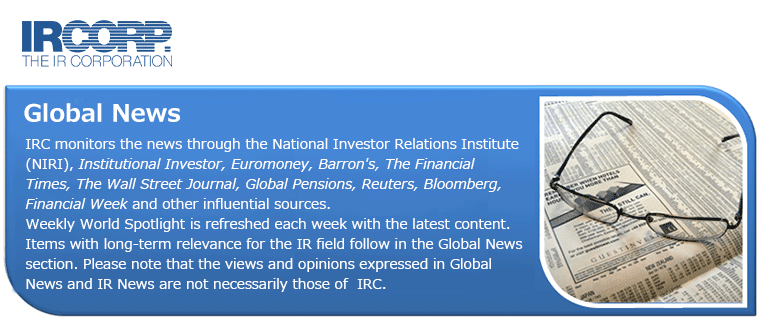Wall Street Journal (July 17)
“A clearer outlook on interest rates is giving bankers hope that dealmaking is emerging from a two-year slowdown.” Though up about 8% from a year ago, Q2 global M&A volumes “are still below those of the deal boom coming out of the pandemic,” with M&A activity “unlikely to kick into full gear until interest rates come down.”
Tags: 8%, Bankers, Boom, Clearer, Dealmaking, Emerging, Interest rates, M&A, Outlook, Pandemic, Q2, Slowdown
Seeking Alpha (May 8)
“Sweden is following Switzerland, Hungary, and the Czech Republic in easing monetary policy for the first time since hiking cycles began in 2022, when inflation surfaced in the aftermath of the COVID pandemic.” The quarter point cut of the overnight rate by the Riksbank makes “it more likely that the ECB will also jump on the bandwagon. The shift is noteworthy to global investors as it highlights the current central bank divergence taking place across the world.”
Tags: Aftermath, Central bank, Covid, Czech Republic, Easing, ECB, Global investors, Hungary, Inflation, Monetary policy, Pandemic, Riksbank, Sweden, Switzerland
Wall Street Journal (March 25)
“Annual issuance of U.S. Treasurys has exploded, nearly doubling since the pandemic began. The government sold a record $23 trillion worth in 2023.” This makes people “nervous” because “rapid growth in markets from tech stocks to mortgage bonds has ended badly in the past.” Given their ubiquity and potentially “unforeseen consequences,” any instability in the Treasury market “could rapidly spread” to other markets.
Tags: $23 trillion, 2023, Doubling, Exploded, Government, Issuance, Mortgage bonds, Nervous, Pandemic, Tech stocks, Treasurys, U.S., Ubiquity, Unforeseen consequences
New York Times (March 14)
Some now fear an “urban doom loop.” Cities are encountering budget crunches brought on by “steep discounts” in office and commercial real estate “as the pandemic trends of hybrid and remote work have persisted.” Cities are “starting to bear the brunt.” Budgets once reliant “on taxes associated with valuable commercial property are now facing shortfalls and contemplating cutbacks as lower assessments of property values reduce tax bills.” Cutting services or raising taxes could make cities less attractive, inducing urban flight and further exacerbating city budgets.
Tags: Budgets, Cities, Commercial, Cutbacks, Discounts, Fear, Hybrid, Office, Pandemic, Property, Real estate, Remote, Services, Shortfalls, Tax, Urban doom loop
Wall Street Journal (February 12)
“Stand in the middle of the business district of any big U.S. city and the nearby buildings are emptier and a lot less valuable than they were four years ago. Listed office real-estate investment trusts have already faced the music: The S&P 500 Office REITs Sub-Industry Index has roughly halved in value since before the pandemic. The reality check for banks is just beginning.”
Tags: Banks, Buildings, Business district, Emptier, Halved, Listed, Office REITs, Pandemic, Reality check, S&P 500, U.S., Valuable
New York Times (February 5)
“A sense of foreboding,” carried over from the pandemic, remains shared by many Americans. Though this “sense of insecurity has seeped into the crevices of everyday experience,” it increasingly seems to “conflict with data points that reflect an unambiguous strengthening of the American economy. Incomes have risen, unemployment remains low and consumer confidence is improving.”
Tags: Conflict, Data points, Economy, Everyday, Foreboding, Incomes, Insecurity, Pandemic, Strengthening, U.S., Unemployment
Financial Times (February 1)
“Mounting losses from banks in the US, Asia and Europe have rekindled concerns about weakness in the US commercial property market, a sector that has been under pressure from lower occupancy levels and higher interest rates.” This week New York Community Bancorp, Aozora Bank and Deutsche Bank each warned of related risks or recognized losses, which “mark the latest fallout from the… dual problems of fewer people working in offices since the pandemic and more expensive borrowing costs.”
Tags: Aozora Bank, Asia, Banks, Commercial property, Concerns, Deutsche Bank, Europe, Fallout, Interest rates, Losses, Occupancy, Offices, Pandemic, Pressure, Risks, U.S., Weakness
Wall Street Journal (January 30)
“Logistics technology companies are cutting costs and slashing staff as a prolonged slump in freight stretches into 2024.” After soaring to “huge valuations during the Covid pandemic when a wave of consumer spending pushed freight volumes and shipping rates to record levels,” high interest rates and weak freight volumes are now “stretching some companies to their limit.”
Tags: Companies, Consumer spending, Costs, Covid, Freight volumes, Logistics, Pandemic, Prolonged, Shipping rates, Slashing, Slump, Staff, Technology, Valuations
Bloomberg (January 26)
In the “race for world’s biggest economy,” the U.S. has extended its “lead over china.” U.S. GDP “rose 6.3% in nominal terms…last year, outpacing China’s 4.6% gain.” Some of that is due to inflation, but the result “underscores a broader point: The US economy is emerging from the pandemic period in a better place than China’s.”
Tags: Better, China, Economy, Emerging, GDP, Inflation, Lead, Outpacing, Pandemic, Race, U.S., World
Washington Post (January 9)
“After rebounding sharply in 2021 from the depths of the pandemic, the global economy grew by 3 percent in 2022, dipped to a 2.6 percent rate last year and is expected to post a tepid 2.4 percent this year” according to the World Bank. “Those rates lag the 3.1 percent average for the decade of the 2010s.”
Tags: 2.4%, 2.6%, 2010s, 2021, 2022, 3.1%, 3%, Global economy, Lag, Pandemic, Rebounding, Tepid, World Bank


